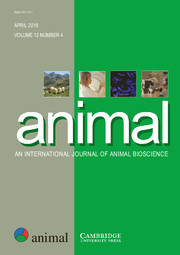View Item
- xmlui.general.dspace_homeCentros Regionales y EEAsCentro Regional La Pampa - San LuisEEA AnguilArtículos científicosxmlui.ArtifactBrowser.ItemViewer.trail
- DSpace Home
- Centros Regionales y EEAs
- Centro Regional La Pampa - San Luis
- EEA Anguil
- Artículos científicos
- View Item
Dissection of ancestral genetic contributions to Creole goat populations
Abstract
Goats have played a key role as source of nourishment for humans in their expansion all over the world in long land and sea trips. This has guaranteed a place for this species in the important and rapid episode of livestock expansion triggered by Columbus’ arrival in the Americas in the late 1400s. The aims of this study are to provide a comprehensive perspective on genetic diversity in American goat populations and to assess their origins and
[ver mas...]
Goats have played a key role as source of nourishment for humans in their expansion all over the world in long land and sea trips. This has guaranteed a place for this species in the important and rapid episode of livestock expansion triggered by Columbus’ arrival in the Americas in the late 1400s. The aims of this study are to provide a comprehensive perspective on genetic diversity in American goat populations and to assess their origins and evolutionary trajectories. This was achieved by combining data from autosomal neutral genetic markers obtained in more than two thousand samples that encompass a wide range of Iberian, African and Creole goat breeds. In general, even though Creole populations differ clearly from each other, they lack a strong geographical pattern of differentiation, such that populations of different admixed ancestry share relatively close locations throughout the large geographical range included in this study. Important Iberian signatures were detected in most Creole populations studied, and many of them, particularly the Cuban Creole, also revealed an important contribution of African breeds. On the other hand, the Brazilian breeds showed a particular genetic structure and were clearly separated from the other Creole populations, with some influence from Cape Verde goats. These results provide a comprehensive characterisation of the present structure of goat genetic diversity, and a dissection of the Iberian and African influences that gave origin to different Creole caprine breeds, disentangling an important part of their evolutionary history. Creole breeds constitute an important reservoir of genetic diversity that justifies the development of appropriate management systems aimed at improving performance without loss of genomic diversity.
[Cerrar]

Author
Sevane, N.;
Cortes, O.;
Gama, L.T.;
Martínez, A.;
Zaragoza, P.;
Amills, M.;
Bedotti, Daniel Osvaldo;
Sousa, C. Bruno de;
Cañon, J.;
Dunner, S.;
Ginja, C.;
Lanari, Maria Rosa;
Landi, V.;
Sponenberg, P.;
Delgado, J.V.;
Fuente
Animal 1-10. (February 2018)
Date
2018-01
ISSN
1751-7311 (Print)
1751-732X (Online)
1751-732X (Online)
Formato
pdf
Tipo de documento
artículo
Palabras Claves
Derechos de acceso
Restringido
 Excepto donde se diga explicitamente, este item se publica bajo la siguiente descripción: Creative Commons Attribution-NonCommercial-ShareAlike 2.5 Unported (CC BY-NC-SA 2.5)
Excepto donde se diga explicitamente, este item se publica bajo la siguiente descripción: Creative Commons Attribution-NonCommercial-ShareAlike 2.5 Unported (CC BY-NC-SA 2.5)

